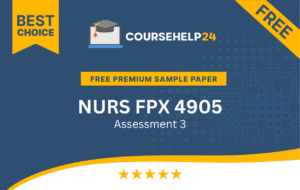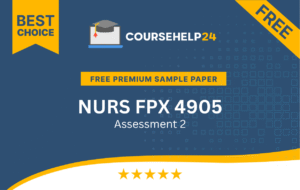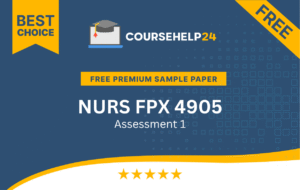NURS FPX 4905 Assessment 4: Improving Medication Adherence Among Older Adults with Hypertension
Due to age-related physiological changes and comorbidities, older persons are disproportionately more affected by hypertension, one of the leading causes of morbidity and mortality worldwide. Despite the effectiveness of the anti-hypertensive medications currently on the market, enhancing medication adherence in older adults is still a significant challenge. This is because low adherence rates continue to restrict the best possible blood pressure control and raise the risk of avoidable complications like heart failure, stroke, and kidney disease. Focusing on drug adherence in this patient population is crucial for improving patient safety, providing high-quality care, and reducing healthcare costs. Therefore, NURS FPX 4905 Assessment 4’s capstone project will concentrate on applying evidence-based interventions. It will also focus on the concept of interprofessional collaboration to enhance medication adherence among the elderly population with hypertension and improve health outcomes.
Leading a Practice Change to Improve Medication Adherence
In nursing practice, leadership has always been crucial, and it remains essential in the broader field of quality improvement initiatives (Yastaas et al., 2023). As a baccalaureate-prepared nurse, I have used transformational leadership ideas to foster an environment of accountability, foster cross-connection among all stakeholders, and advance evidence-based practice in my clinical context. I was able to set up multidisciplinary meetings with doctors, pharmacists, and social workers in order to prepare an interdisciplinary intervention that was focused on the patient after developing a clear vision for improving medication adherence. The NURS FPX 4905 Assessment 4 highlights effective leadership behaviors, such as the implementation of training sessions with the nursing staff to remind them of the value o
motivational interviewing and teach-back strategies to use when organizing patient education programs. Successful use of motivational interviewing by nurses can improve patients’ self-efficacy and medication adherence. I also helped to propose technology alternatives, such as using telemedicine follow-ups and computerized reminders to care for patients who have previously been released.
Applying Quality and Safety Principles
According to organizations like the Institute of Medicine and the Quality and Safety Education of Nurses (QSEN), patient safety and high-quality care are the most important values of nursing practice in NURS FPX 4905 Assessment 4. It may result in the inability to control hypertension, which could cause dangerous side effects and readmission (Huang et al., 2023). I minimized these risks by determining the barriers and experimenting with possible solutions using quality improvement concepts such as PDSA cycles and root cause analysis. The root cause study identified complicated drug schedules, low levels of health literacy, and noncompliance with B as the primary contributing factors. Thus, we developed lean medical routines and, as needed, we partnered with pharmacists to compile drug conciliations and deprescribing. We also conducted a pilot study among the patients who are non-adherent to medications. We could also now provide them with personalized medication timetables and medicine dispensing boxes, which lowered the number of missed doses to a considerable degree. All interventions had to adhere to safety regulations, and we kept an eye on the patients to watch for any possible drug interactions or side effects.
Communicating and Collaborating with the Interprofessional Team
More care coordination, fewer drug-related errors, and patient compliance are all encouraged by a productive professional connection (Abdalla et al., 2023). Through the weekly huddles and electronic health record (EHR) check-ups, I continuously built communication links
Throughout this project, every choice made in NURS FPX 4905 Assessment 4 was in line with the organization’s rules and professional nursing standards. These treatments address the Joint Commission National Patient Safety Goals, particularly pharmaceutical safety, and the American Heart Association’s (AHA) recommendations for the treatment of hypertension. Since they are connected to the health literacy principle established by the Agency of Healthcare Research and Quality (AHRQ), the standards for patient education materials that I followed are both culturally and health-appropriate.
Additionally, because I have been thinking about patient safety in the context of individual agency, the program aligns with the ethical ideals of beneficence and autonomy. Since the EHR records every conversation and interaction I have with patients, I must have complied with the institution’s requirements for data privacy and continuity of treatment.
Improving Population Health and Addressing Health Disparities
Reducing modifiable risk factors (i.e., medication non-adherence) in a susceptible population group will be the immediate population health impact of this project. According to Horvat et al. (2024), older patients typically have to deal with extra issues linked to cognitive
Evaluating the Project Outcomes and Sustaining Change
To guarantee the efficacy and sustainability of practice change, constant evaluation is crucial (Abdalla et al., 2023). Through patient self-reporting, medication refills, and up to three months of follow-up with the blood pressure establishment, we monitored the trends in adherence. The patient’s and staff’s suggestions were taken into consideration in order to continuously adjust the intervention techniques. For instance, in NURS FPX 4905 Assessment 4, some patients mentioned that they felt more comfortable receiving digital reminders rather than paper calendars. For this reason, we wanted to find ways to incorporate mobile health into the plan. I proposed using the opportunity to monitor adherence while performing a routine nursing assessment and entering reminder messages into the EHR work cycle in order to support the plan’s continued execution.
In order to ensure that medication adherence is a major performance indicator of hypertension care in our facility, I also joined the quality improvement team. In an effort to
address new issues, these benefits will be reinforced via regular staff training and consumer feedback systems.
Conclusion
In addition to being an aesthetic issue, medication nonadherence is outside the purview of our management practice and requires a patient-centered, evidence-based resolution. In the context of this capstone project, the problem identified shows how nurses can significantly improve patient outcomes with the help of appropriate leadership, interpretability, adherence to quality and safety regulations, and dedication to professional ethics. By tackling the primary obstacles that older people face, the initiative will improve the quality of life for the elderly population, lower hospitalization rates, and manage hypertension primarily. They must be long-term since the pressure to evaluate performance and the ongoing improvement will help them perform well in the long run. The use of the highlighted project in NURS FPX 4905 Assessment 4 highlights the critical role that nurses play as leaders and change agents in improving population health and healthcare delivery.
References
Abdalla, M., Bolen, D., Brettler, J., Egan, M., Ferdinand, C., Ford, D., Lackland, T., Wall, K., & Shimbo, D. (2023). Implementation strategies to improve blood pressure control in the United States: A scientific statement from the American Heart Association and American Medical Association. Hypertension, 80(10), e143–e157. https://doi.org/10.1161/HYP.0000000000000232
Horvat, M., Eržen, I., & Vrbnjak, D. (2024). Barriers and facilitators to medication adherence among the vulnerable elderly: A focus group study. Healthcare, 12(17), 1723. https://doi.org/10.3390/healthcare12171723
Huang, X., Xu, N., Wang, Y., Sun, Y., & Guo, A. (2023). The effects of motivational interviewing on hypertension management: A systematic review and meta-analysis. Patient Education and Counseling, 112, 107760. https://doi.org/10.1016/j.pec.2023.107760
Ystaas, L. M. K., Nikitara, M., Ghobrial, S., Latzourakis, E., Polychronis, G., & Constantinou, C. S. (2023). The impact of transformational leadership in the nursing work environment and patients’ outcomes: A systematic review. Nursing Reports, 13(3), 1271–1290. https://doi.org/10.3390/nursrep13030108





